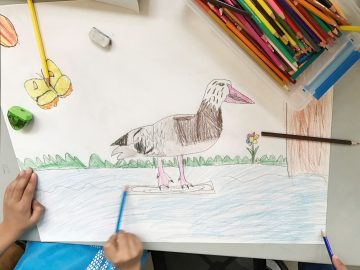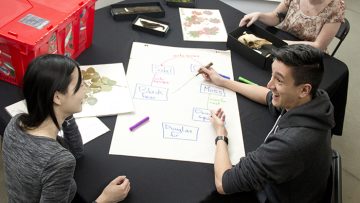
Illustration by Trish Roberts, Exhibits & Design Volunteer, 2016.
Resources can add an educational element to your museum experience, before, during, or after your visit. These museum and educator-developed activities are a great resource for bringing your museum experience into your classroom. The following activities are designed to enhance learning during your visit. As you scroll through, you’ll notice that the educator resources on this page are organized by grade level within each category.
Use our free audio tour at the museum to learn more about our six collections. Bring your own device, headphones, and connect to UBC Visitor WiFi. Click here to view and download a PDF version of our visitor guide.

The following museum activities help to stimulate creativity by encouraging your group to draw their responses:
Victorian Cabinets Identification Guide
Are you curious what the organisms in that glass case are? Here is a guide to the Victorian cabinets in second row of the tetrapod collection. Download this pdf to find that mystery specimen. | All Grades
Creature Features
Hunt for creatures with common features with this printable worksheet. Guide your students using this student example | Grades K-3
Describing and Drawing Organisms
Use clues to find and draw organisms in this printable museum activity | Grades K-3
Tree of Life: Living Things Today and I Wonder
Spend time outside the front door of the museum at the in-ground Tree of Life display that is a part of the Walk Through Time exhibit. Looking at the outer ring, which silhouettes of living things do you recognize? Which do you not recognize? Have students think about and look for recognizable features and characteristics that these living things have. Go inside the museum to find these specimens within the museums’ cabinets, drawers, and displays. Students will draw and label their selected organisms on this worksheet. Use the Teacher Guide and example to help you navigate the museum, learn new terms, and connect to the curriculum. | Grades K-3
What's in each collection?
Find an organism in each of the 6 collections at the museum in this activity | Grades K-3
Visual Timeline Exploration
Inside this package you will find a teacher’s guide as well as worksheets that can be used at either the primary or intermediate level. Depending on how much time you have to explore the museum, and the learning needs of your class, students can either draw the specimens or list them in point form in the table on the worksheets provided. Example guides are also included in the package. | Grades 1-7
Tetrapod Treasures Scavenger Hunt
Explore the second row of the tetrapod collection with this scavenger hunt. Check your answer with this answer key and learn more about each organism with this extended answer key. | Grades 3-7
Aquatic Exploration
Hunt for creatures that depend on the ocean in the museum's collections using this printable aquatic activity . Use the answer key to check your answers! | Grades 4-12
Ocean Pair Up
Use this printable activity to hunt for ocean creatures through common characteristics | Grades 4-12
Explore Evolution Map
Download this pdf map of evolutionary stops in the Beaty Biodiversity Museum. Audio tour links are provided. This map can be used alone or to complement the Explore Evolution Resource Package | Grades 10-12
 The following museum resources require some writing skills:
The following museum resources require some writing skills:
Measurement Fossil Fun
Complement your museum visit with this activity in which students practice making estimates by measuring objects around the museum using their hands as a nonstandard measuring unit, and with a ruler, which is a standard measuring unit. A printable template and a student example are included to help guide your group | Grades K-3
Relationships
Learn about phylogenetic relationships and how organisms are grouped and related using this printable activity. Use this answer key to check your group's work! Note that this activity requires some spelling | Grades K-3
Visual Timeline Exploration
Inside this package you will find a teacher’s guide as well as worksheets that can be used at either the primary or intermediate level. Depending on how much time you have to explore the museum, and the learning needs of your class, students can either draw the specimens or list them in point form in the table on the worksheets provided. Example guides are also included in the package. | Grades 1-7
Exploring Adaptations Package
In this package you will find both a pre-museum activity to complete in your classroom as well as an activity to complete while you are visiting the Beaty Biodiversity Museum. Both activities focus on the concept of physical animal adaptations. | Grades 1-7
Bird and Dinosaur Connection: Elementary
Did you know that dinosaurs still live among us today? Compare and contrast these two groups during your museum visit using this museum scavenger hunt and answer key | Grades 3-7
Hidden Treasures at the Beaty: Escape Room
Head inside the Beaty Biodiversity Museum to solve a mystery! Students will use inquiry-based learning and cross-curricular skills to solve clues throughout the museum collections. Use the museum map to support your quest. Time management and critical thinking skills will be tested along the way.
Download the full teacher guide to explain the process of introducing the activity, including hints and answers. The student clue sheet can be easily printed for each student, and at the end, use our fillable certificate to note each student's accomplishments. | Grades 3-12+
Amazing Evolution
Explore the concept of evolution in depth using this museum scavenger hunt and answer key | Grades 4-12+
Birding Bonanza
Learn how birds connect to their surroundings using this bird-related activity and its answer key | Grades 4-12+
Culture at the Centre Knowledge Path
Explore land and language following six stories that connect these communities to their territories using this printable knowledge path. Visit our exhibitions page to learn more. | Grades 4-12+
Eat or Be Eaten
Explore how organisms eat and avoiding being eaten with this printable activity and its answer key | Grades 4-12+
Forest Biodiversity
Discover more about forest biodiversity in this printable forest-related activity and its answer key | Grades 4-12+
Ocean Biodiversity
Discover more about ocean biodiversity in this museum activity. See the answer key to check your answers! | Grades 4-12+
Urban BiodiverseCity
Discover more about urban biodiversity in this museum activity and check your answers using this answer key | Grades 4-12+
Wetland Biodiversity
Discover more about wetland biodiversity during your museum visit using this printable museum activity and its answer key | Grades 4-12+
Winter Wonderland
Learn about the adaptations organisms have to survive through the winter in this activity and check your answers using this answer key | Grades 4-12+
Evolution Scavenger Hunt
Journey throughout the museum and use the given clues to complete a variety of challenges. Download the scavenger hunt and answer key here. This sheet is best printed on legal-sized paper. | Grades 4-8
Climate Change Exploration
Find exhibits and displays within the Beaty to start to explore climate change and conservation stories using this map as a guide. Download the educator guide to support your students while they explore. | Grades 6-12+
Four-limbed Frenzy
The second row of specimens have the biggest and the brightest of our tetrapods. There are four sections in this row, let's explore them with this worksheet. | Grades 6-12+
Extinction Expedition
Earth’s history is diverse, dynamic, and full of stories. Today, you will take a deeper look into the prehistoric past, and look at events that drastically changed the biodiversity on Earth at specific points in time. Use this worksheet and teacher guide to explore the Walk Through Time outdoor exhibition and indoor museum exhibits. | Grades 7-12+
Beaty Biodiversity Museum Organism Search
A scientist is planning to write an article about the features of some species at the Beaty Museum that allow them to be characterized as living organisms. While the scientist can remember the name of the species they are interested in, they have misplaced their notes on each organism’s features! Your task is to help them collect the information they need before their article is due!
Download the lesson plan with answers and student worksheet here. | Grade 8
Bird and Dinosaur Connection: Secondary
Did you know that dinosaurs still live among us today? Compare and contrast these two groups in-depth during your museum visit using this museum scavenger hunt and answer key | Grades 8-12+
Living Fossils Scavenger Hunts
Learn about the organisms that exist today, and their ancient ancestors while exploring the museum. Use these two scavenger hunts and answer keys that complement each other, while exploring all six of the museum's collections and the Timeline Exhibit. Learn about Fish and Reptiles, and download our answer key. Explore the Tree of Life, and find the answers here | Grades 8-12+
Walk Through Time Scavenger Hunt
Now that you’ve explored the Walk Through Time: Tree of Life exhibit outside of the museum, explore the collections inside! You’ll find organisms that appear on the Tree of Life, with four
examples that are threatened in British Columbia. Download the three-page worksheet and the answer guide. | Grades 8-12+
Classification and Relationships
Explore the museum in search of evolutionary stories through similarities and differences using this museum activity and see this answer key | Grades 10-12+
Research Scavenger Hunt
In this scavenger hunt, students explore research stories in the museum and create their own research topic, and see this answer key to check your answers | Grades 10-12+
Human-Wildlife Interactions and iNaturalist
Students will identify a plant or animal and post your observation to the citizen-science app iNaturalist. After you complete this activity, use the Human-Wildlife Interaction worksheet to explore the Beaty Biodiversity Museum. Download the lesson plan, worksheet, and colouring sheet. | Grade 11
